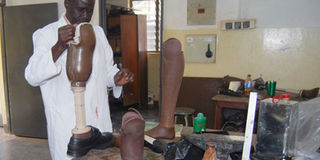20 years of making artificial limbs

Kalanzi shows off one of the artificial limbs made at the orthopedic workshop. Photo by ALICE ADIKIN.
Emmanuel Kalanzi walks me into a dimly lit workshop at the extreme end of the orthopedic department in Gulu Regional Referral Hospital.
This has been Kalanzi’s workplace for 20 years where he was first posted in 1997 from Mulago School of Technology.
Inside the room is a collection of machines placed against or near dusty cream and white walls.
At the extreme end is a large table where the senior technologist at Gulu hospital orthopedic department does much of his work.
Underneath is a lump of clutter and rubber cuttings taken off different materials.
“I first came to Gulu in 1996. I had come with a friend from Italy who was working on ground works to establish an artificial limbs workshop here [Gulu hospital]. Unknowingly, I was being prepared for a new journey,” Kalanzi says narrating how his eventual arrival in 1997 introduced him to new realities of the work ahead after, a few days after his arrival he was asked to forge 25 artificial limbs in just two days.
“There had been fighting between UPDF and LRA and many causalities had lost legs and arms. We had to forge 25 artificial limbs in just two days. It was such an overwhelming job conducted in a high risk environment,” he says.
Starting out
The arrival of Kalanzi had been part of the larger plan through which the Ministry of Health planned to establish four orthopedic workshops in the districts of Mbarara, Mbale, Kabalore and Gulu.
Three of the four centres had already started operating with the one in Gulu delayed over war concerns.
However, much of the foundational works had already been completed with the assistance of the Italian government.
Kalanzi arrived at the climax of the LRA war that had for years been characterised by violent clashes that were occasioned by planting landmines. The landmines, he says, had maimed a number of people and there was urgent need of assistance for victims.
“I never wanted to come here. In fact I used to ask myself why I would be transferred to a war zone. I never liked it but I had to do my duties. But as time went on, I got used and here I am 20 years later,” he says as he holds up one of the limbs forged at the workshop.
Moving to Gulu
Moving to Gulu was never an easy task as Kalanzi would have to think through the idea for more than six months.
“I shared the news [of the transfer] with my wife and she told me to resign from the job. However, as a Christian I put my protection in the hands of God. And it has protected me thus far,” he says.
Kalanzi has now found a home in Gulu where he currently lives with his family.
Apart from working on patients at the workshop, Kalanzi and a team of other workers reach a number of people through outreach programmes in the districts in subregions of Acholi, Lango and parts of the West Nile.
Here, they have been able to work on people with minor injuries with those with severe injuries sent for admission and proper management at the orthopedic department.
In a day, according to Kalanzi, the workshop works on more than 10 patients, some of whom are first time visitors while others are revisiting for adjustments.
Retired
At 65 years Kalanzi would have retired already but was rehired by Avis, a non-government organisation that works with war victims, to continue forging limbs for maimed victims.
The NGO sources much of its material from Geneva, Switzerland and funds much of the activities at the orthopedic department.
Other materials such as wax and natural honey are sourced from within Uganda, especially northern Uganda.




